10 Important Religious Festivals in Ancient Egypt

Ancient Egyptian festivals
In ancient Egypt, the gods and goddesses reigned supreme over all aspects of their daily lives. For example, the Egyptians believed that when one died the jackal-headed god Anubis (god of funerals and mummification) was the one who came to whisk the dead soul away into the underworld for judgement before the other gods. Similarly, the sun was the embodiment of the god Ra (in some cases Amun-Ra), who, on a daily basis, made his journey from the underworld into the sky to illuminate and nourish the day and the people of Egypt. The goddess Bast (or Bastet) was the cat deity who shielded the home from all forms of evil spirits.
As a result of those numerous religious beliefs, ancient Egyptians paid enormous reverence and adulation to the gods. It was not just an important part of their lives, it was a matter of civic and moral duty for every Egyptian, regardless of economic or social class.
The article below explores all the major ancient Egyptian festivals that played a key role in shaping the landscape of Egypt for several millennia.
Significance of ancient Egyptian festivals
Owing to the above ancient Egyptian beliefs, it came as no surprise that the ancient Egyptians took to conducting festivals, celebrated either on particular days or series of days in a year, in honor of their beloved gods and goddesses. Many of those ancient Egyptian festivals (also called heb) were performed in a bid to nudge the people closer to their gods.
Furthermore, the festivals were occasions for the people to express their undying gratitude to the gods for their protection and other blessings.
Ancient Egyptian festivals were opportune moments for the pharaohs to re-establish their legitimacy as chosen rulers or the gods’ representatives on earth. During those festivals, the pharaohs and priests also beseeched the gods to intervene in say a natural disaster that was ravaging and tearing the society apart.
Read More:
Nature of Ancient Egypt festivals
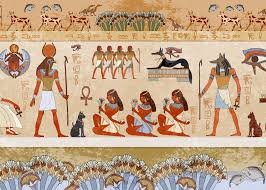
Egyptian Festivals – history and importance
Ancient Egyptian festivals afforded the people the opportunity to come “face-to-face” with the gods, experience them visually and spiritually. By so doing, they could shower thanks and gifts on the gods.
Often times, the statues of the gods were taken out of the inner sanctum of the temples and paraded around the city, allowing people to catch a glimpse of the gods in their divine attributes and splendor. In some cases, the statues were placed in magnificent ships – ships similar to the great solar barge that sun god Ra or Amun is believed to have sailed on across the sky – to be sailed on the Nile.
In order to reinforce the unifying power of the gods, the organizers of the festivals made it a habit of establishing festival centers across the land, in the various cities and towns, to serve as hosts for the religious processions.
The festivals and religious gatherings in ancient Egypt played a huge role in sustaining the people’s belief structure, which in turn helped keep the social and political structure intact. Thus to a large extent, without those festivals the pharaohs and ruling elite would be left with very few avenues to legitimize their god-giving rights to rule all of Egypt.
Participating in the festivals also allowed the people to make sense of how and why things around them worked. Armed with this version of understanding, regardless of how crude we modern humans might find them to be, the society as a whole was more likely to be satisfied and less prone to questioning the ruling elite’s authority.
Read More:
Nature of religious practices in ancient Egypt
Were one to travel through time, to the period when those ancient Egyptian festivals occurred, it would come as no surprise to know that the type of religious services practiced then was different from the ones we see today.
First thing that you would notice is that the priests and ruling elites played larger role in the festivals. The priests were the ones who tended to needs of the gods and the temples. They were required to offer prayers and sacrifices to the various gods least the gods turned their backs on the land.
As it was common with many ancient beliefs, the ancient Egyptians believed that the gods literally dwelled in the magnificent temples. And just to show how centralized the religious practice and festivals were, only the high priests and priestesses, or in some cases the pharaoh, were allowed to enter the inner sanctum of the temples.
With the exclusion of hand few of people, the common people were generally not allowed to even worship in the inner parts of the temples. The people could however make prayers and offer sacrifices in the outer sections of the temple complexes.
Participation and organization
With the above said, the festivals and special religious gatherings were the only time that commoners and other lower classes of the society got to come closer to the gods.
Broadly speaking, there were two types of festivals; they were – national and local festivals. With the exception of a few bits and pieces of information about what really transpired in those ancient Egyptian festivals, there is not much that is known about the numerous festivals that occurred.
Major Ancient Egyptian Festivals
The following are 10 major ancient Egyptian festivals:
Wapet-Renpet Festival
This festival was conducted to usher in the New Year. It was thus known as the Opening of the Year Celebration. The ancient Egyptians celebrated Wapet-Renpet depending on the flooding of the Nile River. It was also believed that it commemorated the death and rebirth of Osiris, the Egyptian god of the afterlife. The story surrounding Osiris’ resurrection symbolized the revival of the society as a whole. This festival could last for days, as the people wined and feast.
The priests and pharaoh used the Wapet festival to implore the gods for favors, while at the same time offering copious amounts of prayers and sacrifices to the gods, particularly Osiris.
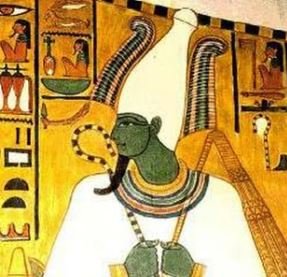
Egyptian god Osiris was often depicted with a green skin to symbolize his dominion over the afterlife and power over rejuvenation
Opet Festival
The Opet Festival is usually ranked as one of the most important religious festivals in ancient Egypt. Why? This festival was simply a time to ask for the gods to strengthen and rejuvenate the pharaoh. Particularly, the god Amun – the sun god and later chief of the gods – was implored to nourish the life of the pharaoh and his/her family.
Opet Festival likely started around the Middle Kingdom (c. 2040 – c. 1640 B.C.E) before it grew extremely famous in the New Kingdom (c. 1552 – c. 1070 B.C.E).
The festival began by washing and decorating the statue of Amun. Shortly after that the priests of Amun recited a number of prayers and incantations before sending the statue out in a procession through the streets of Thebes. Owing to how important this festival was to the people, several scores of people would troop into the streets to catch a glimpse of Amun’s statue. Many believed that seeing the statue of Amun came with enormous blessings from the gods.
After its street procession, the statue made its way to Luxor on a beautifully decorated barge. Upon its arrival to the temple, the pharaoh is ushered into the inner sanctum of the temple of Amun. The pharaoh’s going in and out of the temple symbolized his rebirth. And by so doing they believed that the ruler’s sins or transgressions were all forgiven by the gods.
Did you know: 20th Dynasty pharaohs of Egypt spent at least three weeks celebrating the Opet Festival?
Wag Festival
In simple terms, the Wag Festival was an opportune time of the year for the Egyptians to honor the memory and souls of the dead. It was to shore up the vitality of the deceased as they made their way in the afterlife.
Inspired by themes of the Osiris myth, the Egyptians believed that the dead also needed their prayers and respect. The rituals were almost similar to the Wapet festival; however, the Wag Festival was more of a solemn kind of event than a celebratory event. During the Wag Festival, the participants would carve small paper boats and then let them float towards the west. A symbolism of the journey Osiris made at sunset in his solar barque.
Bast/Bastet Festival
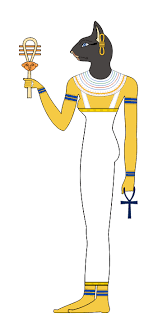
The cat goddess Bastet was generally called upon to keep the homes of Egyptians free from evil spirits
Every time that Bast festival occurred in ancient Egypt, the goddess Bast’s cult center turned into one of the liveliest places in the land. The Egyptians honored Bast (also known as Bastet) – the feline goddess of protection, magic and potions – for keeping the land of Egypt free of malicious spirits such as Apophis. It was a time to honor the birth of Bastet, who like Sekhmet and Hathor were associated to the Eye of Ra. Particularly, Bast protected women and children; she was in charge of everything home related.
Such was the reputation of Bast Festival that the great Greek historian Herodotus stated that the festival was most famous ancient Egyptian festival. During the festival, women were given preferential treatment and received a lot of pampering. They were allowed to kick up their feet and drink and dance. According to some ancient scholars, the women engaged in what was termed as “raising of the skirts”, where they danced in wild abandon, often times showing their genitals. This was the level of freedom women were afforded to have during Bast Festival.
Read More:
- Myths and Facts about Set – the Egyptian god of chaos and destruction
- 10 Most Worshiped Goddesses in Ancient Egypt
Tekh Festival
Also known as the Feast of Drunkenness, the Tekh Festival in ancient Egypt was a time that saw ancient Egyptians go wild by shedding all forms of inhibitions. It was a festival used to honor Hathor, the sky goddess and goddess of protection. Hathor was also revered as the consort of the sky god Horus or the sun god Ra. So why did the Egyptians drink excessively in honor of Hathor?
According to the myth, the sun/creator god Ra sent the ferocious goddess of war and protection Sekhmet to unleash the harshest form of punishment upon the people of Egypt, who at that time was incorrigible and cruel. Sekhmet is believed to have carried out Ra’s instructions to the letter; even throwing in some kind of her own twisted punishment.
With Sekhmet’s destruction seeing no end in sight, the other Egyptian gods began to grow very concerned, fearing that Sekhmet’s carnage could cause everyone in the land of Egypt to die. The gods implored Ra – chief of the gods – to halt Sekhmet’s destruction and thirst for blood.
Ra is believed to have instructed the people of Egypt to dye the color of the brewed beer red and then place it in the path of Sekhmet. Thinking that the red beer was blood, Sekhmet quickly drank copious amount of it and went into a deep sleep. Hanged over and perhaps remorseful of her actions, the goddess of destruction woke up and transformed into a calmer goddess, who ultimately became the benevolent goddess Hathor.
So, every year, starting around the Middle Kingdom, the people of Egypt celebrated Tekh Festival by drinking excessive amounts of beer in order to commemorate Sekhmet’s transformation into Hathor. During this festival of drunkenness, the priests and worshippers would get drunk in the temple complexes only for them to be woken up by musicians the following day. Once they were up, the worshippers would then offer solemn prayers of devotion and gratitude to the gods for sparing their lives from the recklessness of Sekhmet.
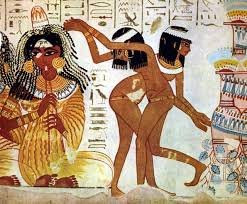
Ancient Egyptian Festivals
Hathor Festival
Unlike some ancient Egyptian deities who were both feared and revered, perhaps it is safe to say that the goddess Hathor was a very adored and benevolent deity. Hathor was the sky goddess and the divine mother of Egyptian pharaohs. Owing to her motherly traits, which were generally the complete opposite to the goddess Sekhmet, Hathor was celebrated for her role in nourishing the people of Egypt. It was as a result of this role of Hathor that the Egyptians symbolized her with a cow.
The religious activities that took place during Hathor Festival were a bit similar to the ones that occurred during the Tekh Festival. The epicenter of Hathor Festival was usually held at Dendera – the location of Hathor’s main cult. Owing to how much of a reverence the people gave to the goddess, Hathor festival was one of the most eagerly anticipated Egyptian festival of the time. Participants sang and made merry; the society was generally kind during the festival.
Min Festival
Named after the fertility and male procreative god Min, the Min Festival is perhaps one of the oldest Egyptian festivals on this list. Scholars estimate that honouring of the god began around the Predynastic Period (before 3100 BCE). Owing to how old the festival is not many details about this festival exist to this day.
However, what we know is that the priests of the temple of Koptos and Akhmim paid immense amount attention on the statues of Min, decorating them with ornaments only rivalled by those of the pharaoh. The statue of Min is then carried out in a procession through the streets. Once the statue reaches a point in its procession, the pharaoh was required to harvest the first sheaf of grain before offering it as sacrifice to the god. To the people of Egypt, this act of the pharaoh showed his divine connection with the god Min. The Min Festival, similar to Hathor Festival, was a way to ask the gods to rain blessings and bountiful harvest upon the people.
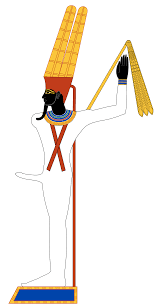
Image of the fertility god depicted with an erect penis, a symbol of his male procreative power
Wag and Thoth Festival
The god Thoth was revered in ancient Egypt as the god of writing, knowledge and wisdom. Thoth was also a very influential deity when it came to judging the souls of the deceased in the underworld. He was present during the weighing of the heart ceremony in the Halls of Ma’at, where the deceased heart is weighed against the feather of Ma’at (the goddess of truth, justice and order).
So it was not out of place that the ancient Egyptians paired Thoth’s festival with that of Osiris’ to form the Wag and Thoth Festival. Both gods played crucial role in the afterlife; and as such they were very significant to the Egyptians. Although details about exactly what transpired during this festival remains a bit scanty, scholars claim that this festival particularly celebrated Thoth’s birth and Osiris’ rebirth. It most likely would have bordered on themes of the pursuit of knowledge and the advancement of the land of Egypt.
Wadi Festival
The Wadi Festival was basically a series of religious ceremonies used to honor the souls of the dead. However, rather than it being one of solemnity and soberness, it was a time to celebrate the lives well lived by the deceased.
Also known as the Beautiful Feast of the Valley, the Wadi Festival did not just honor the deceased, it also heaped enormous praises on the god Amun. Along with his son, the god Khonsu, and his consort, the mother goddess Mut, Amun made up the very famous Theban Triad of gods. In view of this, Wadi Festival saw all three statues of those gods briefly moved from their respective temples to the mortuary temples (the necropolis). This act brought the gods closer to the resting places of their deceased, imbuing in them ample blessings for their journeys in the afterlife.
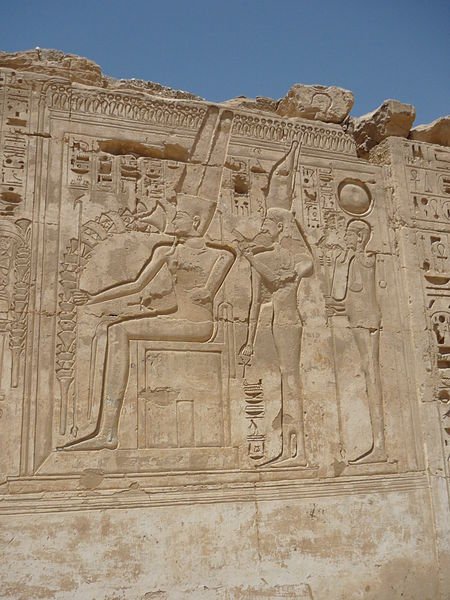
Wall relief of Amun-Ra, Mut and Khonsu (left to right), mortuary temple of Ramses III, Medinet Habu, Theban Necropolis, Egypt
Sokar Festival
In some cases, the Sokar Festival was known as the Festival of Khoiak. This festival takes its name from the god Sokar – a minor Egyptian god of agricultural whose worship began long before the Old Kingdom (c. 2686 – c. 2134 B.C.E).
The Sokar Festival was used to commemorate all the bountiful harvest bestowed upon the Egyptians by the god Sokar.
As a result of Osiris’ later association with the god Sokar, ancient Egyptians combined Osiris’ Khoiak Festival of Rejuvenation with that of Sokar Festival. In the years that followed, worship of Osiris overshadowed that of Sokar during the festival. However, at the core of it, ancient Egyptians saw the role of Osiris similar to that of any agricultural god in the Egyptian pantheon.



























